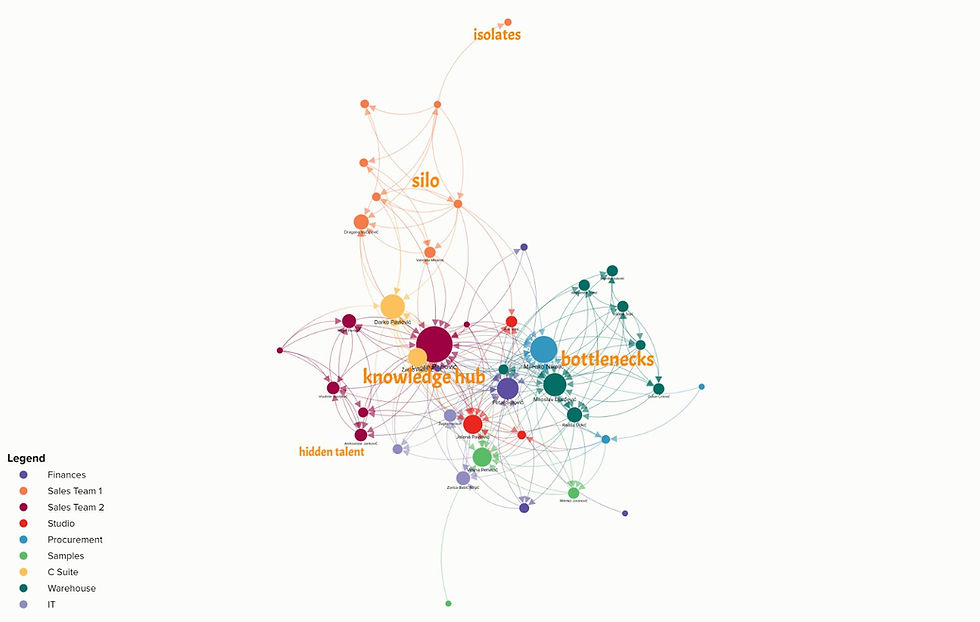Organizational Network Analysis: Case study
- Maja Ninkovic
- Oct 12, 2018
- 3 min read
Organizational Network Analysis represents one of the most powerful analytical tools in the area of business/organizational research. ONA is a data-driven organizational methodology that provides business intelligence by analyzing the existing patterns of relationships and interactions among employees in organizations.
People Analytics Hub is sharing one great example of the benefits this kind of analysis can bring to the organization. The ONA analysis took 3 months to complete and resulted in increased organizational functioning and a significant improvement in employee performance in all key areas.
CHALLENGE
Our client in the sales industry had a pressing issue: the organization was experiencing significant growth, but the human infrastructure - collaboration, communication and information flows couldn't keep up. There were numerous gaps and delays in providing and recieving necessary information across departments which slowed down the employee efficiency and caused delays in customer response time. Employees were overburdened with additional work and constant interruptions of regular workflow, and consequently, started experiencing lower satisfaction and engagement. Cross-functional collaboration was affected, and department heads found themselves in a siloed environment that had negative effects both for employees and the company's customer base.
METHOD
We applied the Organizational Network analysis in 4 domains to help the senior management answer some key questions related to their human infrastructure. We conducted:
1. Information flow network analysis to tell us...
a.) Where are the bottlenecks in the organizational information flow?
b.) Which departments have lower levels of information sharing with others?
c.) Which employees experience informational and collaborative overload?
2. Expertise network analysis to tell us...
d.) Which employees represent central knowledge hubs and where are the retention threats in the company?
e. ) Where are organization's hidden talents?
f.) How big is the risk of network breakdown if key individuals leave the organization?
3. Trust networks to tell us...
g.) What is the overall level of interpersonal trust in the organization?
h.) Where are critical points in the organization where trust needs to be improved?
4. Innovation networks to tell us...
i.) What is the overall innovation potential of the company?
j.) Which employees are the central innovation hubs in the company?
k.) How to boost cross-departmental collaboration for maximum innovation impact?
One example of the ONA analysis mapping - Expertise
The expertise analysis is designed to map and characterize the existing communication structure among individuals in an organization as it relates to providing expert advice or solutions to work-related problems. It was used here to identify organizational members who are most often sought out for expertise needed to accomplish work-related tasks (knowledge hubs), overly connected individuals who may be slowing the work of others (bottlenecks), or organizational members who are either disconnected from or only loosely connected to the rest (isolates), as well as 'siloed' departments that work in relative isolation from others.
Figure 1. A simplified example of an expertise network map for our client

RESULT
Armed with ONA insights, senior management embarked on short-term and long term changes in the organization, as recommended by our team. Some of the implemented changes include:
1. Creation and implementation of the new data- and information-sharing strategy, including the implementation of a new, integrated and more user-friendly information system
2. Reduction of collaborative overload at bottleneck points, through communication diaries, team discussions and more effective delegation to less overloaded individuals
3. Strengthening of the knowledge/expertise capacities at underutilized points in the network
4. Building of interpersonal trust through a targeted program of cross-departmental formal and informal activities (formation of expert groups, team building, informal gatherings)
5. Integration of 'siloed' teams through knowledge exchange and information sharing efforts
6. Focus on innovation through establishment of a more structured and effective communication channel between the customers, sales team and the rest of the organization
Senior management reports positive results in different areas of organizational functioning only 6 months after implementation, experiencing greater employee satisfaction and egagement, less delays in information and knowledge-sharing, more cohesiveness among departments and an increase in customer satisfaction with the level of services provided.
ONA project phases:
1. Define key business objectives to be achieved by the application of the Organizational Network Analysis. 2. Data collection through a short 10 minute survey administration to your employees.
3. Data analysis through visual representation of different networks (information, expertise, trust innovation, etc.), including positioning of individuals and calculation of relevant network metrics and indicators. 4. Follow up with stakeholders to discuss preliminary ONA results, draw out further qualitative observations and clarifications about the networks’ functioning. 5. Report with main findings, including a set of detailed recommendations on how to increase network effectiveness and overall organizational functioning in key business areas.
























Comments